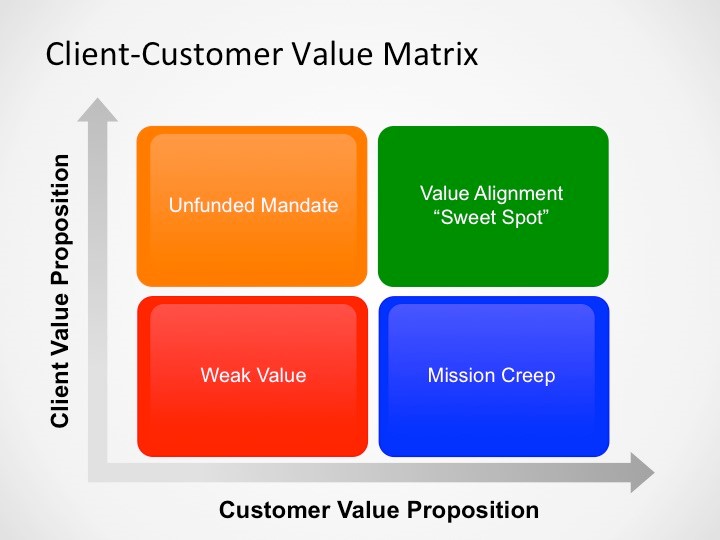Field Notes
What’s So Special about Nonprofit Strategy Anyway?
Peter Drucker boiled down strategy to 5 ESSENTIAL QUESTIONS:
- What is your mission?
- Who is your customer?
- What does your customer value?
- What results do you seek?
- What is your plan?
So, know your customer; what your customer values; and you’re good to go, right?
Not so fast. Nonprofit strategy has an extra complication: the people you serve are usually not the ones who pay for the work. It’s hard enough having one type of customer value your work—try having two!
At Root Cause we call this the client-customer value matrix. In simple terms:
- Clients are the ones who directly see benefit from an organization’s work (One could argue that we all indirectly benefit from what nonprofits do)
- Customers are the ones who pay for an organization’s work
Here’s how the matrix works:

In an ideal world, every organization would be in the top right quadrant—the Value Alignment Sweet Spot—where customers and clients see strong value in an organization’s work. For example, YearUp provides best-in-class training programs for urban youth and places them with companies that are challenged by the skills gap in the labor market. The client—the young trainee—gets a great training program and the company, which pays YearUp a placement fee, gets a trained employee. That’s value alignment.
Many of us are all too familiar with the top left quadrant—the Unfunded Mandate —when you know you are doing important work that benefits the client, but no one wants to pay for it. Some social issues move donors to give and others, not so much. Programs that rely on government funding are particularly vulnerable to this phenomenon because government contracts rarely cover the true cost of service delivery, and private donors are reluctant to fill the gap for fear of incentivizing government to underfund more.
How do you move toward the Value Alignment Sweet Spot?
Find the customers who will also see a return on the investment. When assessing potential customers, remember that those who pay are not acting solely out of altruism, and their motivations make some cases for investment more effective than others.
The return on investment may be an explicit exchange, as is the case with YearUp’s customers. Usually, the value exchange is more nuanced. Donors may invest in programs that help immigrants and refugees, for example, because their grandparents had a similar experience, and they view their support as an acknowledgement of their heritage.
With the client-customer matrix in mind, we would amend Drucker’s essential strategy questions:
- What’s your mission – who are your clients and why do you serve them?
- Who is your customer – donors, businesses, or government?
- What does your customer value – altruism, community, or self-interest?
- What results do you seek – what does your program deliver for your client and your customer?
- What’s your plan – how will you keep the values of the customer and client in alignment?
How would you answer these questions for your organization? What are your struggles with finding an answer that works?
